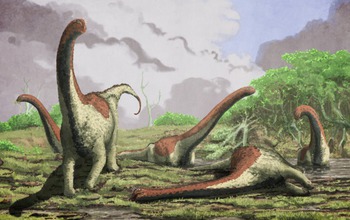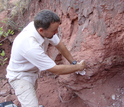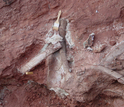Rare find of sauropod dinosaur skeleton from Africa
 Credit and Larger Version |
For video b-roll associated with this discovery, please contact Dena Headlee at dheadlee@nsf.gov.
Paleontologists have identified a new species of titanosaurian, a member of the large-bodied sauropods that thrived during the final period of the dinosaur age, in Tanzania.
Although many fossils of titanosaurians have been discovered around the globe, especially in South America, few have been recovered from the continent of Africa.
The new species, named Rukwatitan bisepultus, was first spotted embedded in a cliff wall in the Rukwa Rift Basin of southwestern Tanzania.
With the help of professional excavators and coal miners, the scientists unearthed vertebrae, ribs, limbs and pelvic bones over the course of several months.
CT scans of the fossils, combined with detailed comparisons with other sauropods, revealed unique features that suggested an animal that was different from previous finds--including those from elsewhere in Africa, according to a paper published today in the Journal of Vertebrate Paleontology.
"This titanosaur finding is rare for Africa, and will help resolve questions about the distribution and regional characteristics of what would later become one of the largest land animals known," says Paul Filmer, a program director in the National Science Foundation's (NSF) Division of Earth Sciences, which funded the research.
"Titanosaurians make up the vast majority of known Cretaceous sauropods, and have been found on every continent, yet Africa has so far yielded only four formally recognized members."
Rukwatitan bisepultus lived approximately 100 million years ago during the middle of the Cretaceous Period.
Titanosaurian sauropods, the group that includes Rukwatitan, were herbivorous dinosaurs known for their iconic large body sizes, long necks and wide stance.
Although not among the largest of titanosaurians, Rukwatitan is estimated to have forelimbs reaching 2 meters and may have weighed as much as several elephants.
"Using traditional and new computational approaches, we were able to place the new species within the family tree of sauropod dinosaurs and determine its uniqueness as a species--and to delineate other species with which it is most closely related," says lead paper author Eric Gorscak, a biologist at Ohio University.
The dinosaur's bones exhibit similarities with another titanosaurian, Malawisaurus dixeyi, previously recovered in Malawi.
But the two dinosaurs are distinctly different from one another, and from titanosaurians known from northern Africa, says co-author Patrick O'Connor, an anatomist at Ohio University's Heritage College of Osteopathic Medicine.
The fossils of middle Cretaceous crocodile relatives from the Rukwa Rift Basin also exhibit distinctive features when compared to forms from elsewhere on the continent.
"There may have been certain environmental features, such as deserts, large waterways and/or mountain ranges, that would have limited the movement of animals and promoted the evolution of regionally distinct faunas," O'Connor says.
"Only additional data on faunas and paleoenvironments from around the continent will let us further test such hypotheses."
In addition to providing new data about species evolution in sub-Saharan Africa, the results contribute to fleshing out the portrait of titanosaurians, which lived in habitats across the globe through the end of the Cretaceous period.
Their rise in diversity came in the wake of the decline of another group of sauropods, the diplodocoids, which include the dinosaur Apatosaurus.
"Much of what we know about titanosaurian evolutionary history stems from numerous discoveries in South America--a continent that underwent a steady separation from Africa during the first half of the Cretaceous Period," Gorscak says.
"With the discovery of Rukwatitan and study of the material in nearby Malawi, we are beginning to fill a significant gap from a large part of the world."
Co-authors of the paper are Nancy Stevens of the Ohio University Heritage College of Osteopathic Medicine and Eric Roberts of James Cook University of Australia.
The study was also funded by the National Geographic Society, the Ohio University Heritage College of Osteopathic Medicine and the Ohio University Office of the Vice President for Research and Creative Activity.
-NSF-
Media Contacts Cheryl Dybas, NSF, (703) 292-7734,
cdybas@nsf.gov
Andrea Gibson, Ohio University, (740) 597-2166,
Andrea Gibson, Ohio University, (740) 597-2166,
The National Science Foundation (NSF) is an independent federal agency that supports fundamental research and education across all fields of science and engineering. In fiscal year (FY) 2014, its budget is $7.2 billion. NSF funds reach all 50 states through grants to nearly 2,000 colleges, universities and other institutions. Each year, NSF receives about 50,000 competitive requests for funding, and makes about 11,500 new funding awards. NSF also awards about $593 million in professional and service contracts yearly.
Useful NSF Web Sites:
NSF Home Page:
NSF Home Page:
http://www.nsf.gov
NSF News:
NSF News:
http://www.nsf.gov/news/
For the News Media:
For the News Media:
http://www.nsf.gov/news/newsroom.jsp
Science and Engineering Statistics:
Science and Engineering Statistics:
http://www.nsf.gov/statistics/
Awards Searches:
Awards Searches:

NSF-funded paleontologists discover new species of dinosaur in Tanzania.
Credit and Larger Version

View of the Rukwatitan quarry shows the "vertical nature" of the scientists' working conditions.
Credit and Larger Version

The humerus, or upper arm bone, and ribs of Rukwatitan in a cliff; the 2-inch brush is for scale.
Credit and Larger Version

Researcher Eric Gorscak quarrying in the Rukwa Rift Basin in southwestern Tanzania.
Credit and Larger Version

Paleontologists remove the remaining portions of Rukwatitan's skeleton from the quarry.
Credit and Larger Version

Image showing two tail vertebrae of the newly discovered Rukwatitan.
Credit and Larger Versión
The National Science Foundation (NSF)
Guillermo Gonzalo Sánchez Achutegui
Inscríbete en el Foro del blog y participa : A Vuelo De Un Quinde - El Foro!

No hay comentarios:
Publicar un comentario